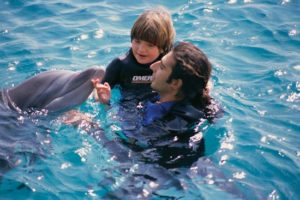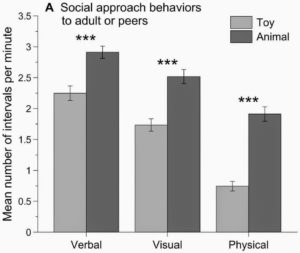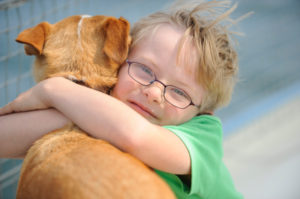Although every case of autism is unique, many overarching therapies can be used to help autistic children anywhere on the spectrum. A fairly successful therapy called animal-assisted therapy can greatly aid autistic children in overcoming many autistic related obstacles. Animal-assisted therapy is a “treatment” in which autistic children interact with some form of animal which can be dogs, horses, and even dolphins.
There are many benefits to animal-assisted therapy . These can include better communication skills in a group, attentional improvement, and reducing stress. Research shows that after playing with toys and playing with animals autistic children “received more social approaches from their peers” and “demonstrated more social approach behaviors (including talking, looking at faces, and making tactile contact)” after the interplay with animals. Still other research observed that after interacting with a dog, children showed fewer behaviors associated with autism such as “hand-posturing, humming and clicking noises, spinning objects, repetitive jumping, roaming” and instead showed more “socially appropriate” ones such as hugging, imitation of the therapist, and offering the therapist balls and balloons.
. These can include better communication skills in a group, attentional improvement, and reducing stress. Research shows that after playing with toys and playing with animals autistic children “received more social approaches from their peers” and “demonstrated more social approach behaviors (including talking, looking at faces, and making tactile contact)” after the interplay with animals. Still other research observed that after interacting with a dog, children showed fewer behaviors associated with autism such as “hand-posturing, humming and clicking noises, spinning objects, repetitive jumping, roaming” and instead showed more “socially appropriate” ones such as hugging, imitation of the therapist, and offering the therapist balls and balloons.
Both emotional and social improvements are made through autistic children’s basic interactions with animals. In O’Haire et al., researchers concluded these correlations and presented a visual representation of what they found.

 Emotional displays of happiness were shown more after interactions with a guinea pig vs. with a toy. Social approach behaviors also happened more frequently while interacting with an animal than with a toy.
Emotional displays of happiness were shown more after interactions with a guinea pig vs. with a toy. Social approach behaviors also happened more frequently while interacting with an animal than with a toy.
Although there are varying theories for why animals cause such a positive impact on the human attitude and behavior, it is clear that the hormonal aspects of animal-assisted therapy are beneficial. One study showed the relationships and interactions that autistic children have with a pet cause a decrease in specific hormones involved with stress such as aldosterone, cortisol, adrenaline, while simultaneously increasing positive hormones such as oxytocin and dopamine. These hormones help associate happiness and decreased stress with less autistic repetitive actions and more with social behavioral skills.
Here’s a quick video from a news source that shows dog-related animal-assisted therapy in action:
Although animal-assisted therapy may seem like a no-risk solution to many autism-related issues, there are downsides to it. Research done by the University of Baylor shows safety is a major factor to consider when dealing with animal-assisted therapy because both animals and autistic children are considered “vulnerable groups,” or groups that are at high risk for mental and physical injury. Large animals such as dogs, dolphins, and horses can lead to broken bones and bites. Although the children are often considered with these factors, animals are also at risk. “Aggression” and “rough handling” can be problems especially concerning autistic children who cannot fully grasp the implications of such actions.
Despite its liabilities, animal-assisted therapy can prove very beneficial to children on the autism spectrum. The positive correlations in both social interactions and emotions outweigh the negative side-effects. Hopefully, further research can be conducted in order to safely integrate more animals into autistic children’s lives.
I really enjoyed your blog post and it gave me yet another reason (among the thousands of others) to absolutely adore animals. I think it’s amazing that there are studies being conducted to show how important animal contact can be on human health and behavior. I thought the video was a good visual representation of showing the importance of having both an animal and a program geared toward helping autistic kids in social situations. I think it’s fascinating that Buster the dog will be trained to identify repetitive behaviors or notice when a child could harm themselves and stopping them from doing so which in turn trains the child.